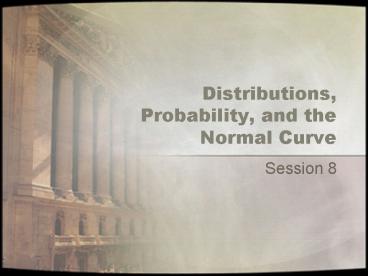Distributions, Probability, and the Normal Curve
1 / 13
Title: Distributions, Probability, and the Normal Curve
1
Distributions, Probability, and the Normal Curve
- Session 8
2
(No Transcript)
3
- In research we often work from a sample to a
population - We draw conclusions from the sample about the
population using probabilities - Example Jar of marbles 50 white, 50 black
- Example Jar of marbles 90 black, 10 white
- By knowing the makeup of a population, we can
determine the probability of obtaining specific
samples
4
- With the marbles examples, we begin with a
population and then use probability to describe
the samples that could be obtained. This is
exactly backward from what we will do with
inferential statistics. - Example Jar of marbles which jar was it,
based on the marbles you picked?
5
- The inevitable, unavoidable definition
- In a situation where several different outcomes
are possible, we define the probability for any
particular outcome as a fraction or proportion.
If the possible outcomes are identified as A, B,
C, D, and so on, then - probability of A number of outcomes classified
as A - total number of possible outcomes
6
- Example p (ace) 4/52
- p (king of hearts) 1/52
- note that probability is defined as a proportion
as in, out of the whole deck, what proportion
are kings? - p (spade) 13/52 1/4
- p (heads) 1/2 in a coin toss
- decimals or percentages can be used as well
- p 1/4 0.25 25
- probability values are most often expressed as
decimal values, but any of the forms (fraction,
proportion, percentage) is acceptable
7
- Note that probability values are bounded between
0 and 1 - Example A jar with all white marbles
- p (black) 0
- p (white) 1
- Two requirements for a random sample
- 1. Each individual in the population must have an
equal chance of being selected p (i) 1/N - 2. If more than one individual is to be selected
for the sample, there must be constant
probability for every selection p (jack of
diamonds)
8
Probability and Frequency Distributions
- ? Populations can be displayed as a graph
- ? Portions of the graph represent portions of the
population - ? Because probability and proportion are
equivalent a particular proportion of the graph
corresponds to a particular probability - ? Whenever a population is presented in a
frequency distribution graph, it will be possible
to represent probabilities as proportions of the
graph.
9
(No Transcript)
10
The Normal Distribution
- Symmetrical
- Can be described by the proportions of area
contained in each section of the distribution - Sections of the normal distribution can be
identified by z-scores
11
- Example We have a feeling thermometer for
President Bush. Scores have a mean of 68 and are
normally distributed. What is the probability of
randomly selecting an individual who scores
President Bush at 80? - p (X gt 80) ?
- Translate to a proportion question what
proportion is greater than 80? In other words,
what proportion is to the right of 80? - Identify the position of 80 by computing a
z-score - z 80 68/6 12/6 2.00
12
(No Transcript)
13
Looking Ahead to Inferential Statistics
Original Population
Treatment
Sample
Treated Sample































